By George W. Chapman
Hospital rankings released
After months of delay due to concerns about the methodology used, the Centers for Medicare and Medicaid Services (CMS) released the results of its hospital quality rankings. 4,600 hospitals received from one to five stars based on 64 quality measures like post-surgical infection rates, average waiting time in the emergency department, readmission to the hospital after a heart attack, use of CT and MRIs, complications after hip surgery, etc. Only 102 hospitals (2 percent) earned five stars. 934 (20 percent) earned four stars. 1,770 (38 percent) earned three stars. 723 (16 percent) earned two stars. 133 (3 percent) earned one star. 937 hospitals (20 percent) received no ranking due to insufficient data. NYS had the most one-star hospitals with 35 of the 133. Thirty three of those 35 were downstate. Faxton-St. Luke in Utica and SUNY Health Science Center in Syracuse were the two Upstate hospitals getting a single star. Many believe the rankings were biased against teaching hospitals, which typically treat more trauma, transfers from other hospitals and the more complex cases. Go to www.cms.gov and look for “CMS Hospital Compare” online to check a hospital’s ranking.
Cancer survivors increasing
The number of cancer survivors will increase by 11 million over the next two decades, according to the National Cancer Institute. Its numbers will increase from the current 15 million to over 26 million. Almost 75 percent of the survivors will be over 65 by 2040.
Text messaging your physician
CMS is working on guidelines for text messaging. The availability of better and secure text messaging technology caused CMS to reconsider its ban on text messaging which has been in force since 2011. Various studies indicate text messaging can accelerate care, boost communications between patients and their providers and streamline patient activity. A recent study of women diagnosed with breast cancer found a much higher level of satisfaction with both treatment plans and their decision making among women who used some means of electronic communication with their physician.
Healthcare to be 20 % of GDP
According to Office of the Actuary under CMS, healthcare expenditures will grow 5.8 percent a year between now and 2025. That is about 1.3 percent faster than the rest of the economy, which could make healthcare 20 percent of the gross domestic product — or GDP — by 2025. We spent $3.2 trillion last year on healthcare. The Affordable Care Act has been credited with keeping annual increase to “moderate levels” compared to the 8 percent growth rate in the two decades prior to the ACA. Price inflation accounted for less than 1 percent of the increase in expenditures. We continue to spend far more per capita or percentage of GDP, than any other country.
Curbing fraud
Penalties will soon double. The minimum penalty for each false claim submitted to CMS will double from the current $5,500 to nearly $11,000. The maximum penalty per false claim would increase to over $21,000. There are typically thousands of false claims in a particular case meaning penalties reach into the million and sometimes billions. Whistleblowers receive a cut of the monies recovered. Many feel the higher penalties may invoke the constitutionality of the fines as a defense. The eighth amendment prohibits excessive fines. However, most cases are settled on damages or the government’s actual losses versus penalties.
Trump’s plan
Republicans have tried to repeal the ACA nearly 50 times. Donald Trump has vowed to repeal it if elected. According to the non-partisan Center for Health and Economy, Trump’s plan would upend most of the recent reforms under the ACA. Eighteen million Americans would lose their insurance due to elimination of tax credits and Medicaid expansion. Premiums would decrease across all plan categories (bronze, silver, platinum) by removing actuarial rating and deductible restrictions and the individual mandate. Medical productivity would increase 2 percent due to a shift from employer-sponsored plans to individual plans. More cost sharing would result in a more price-conscious consumer. Provider access would increase 11 percent based on the assumption that new low-benefit, low-premium catastrophic plans would offer a wider network of providers. The federal deficit would decrease $583 billion over the next decade due to provisions directly related to removing the standard benefit packages under the ACA.
Feds to Increase value of primary care
In a continuing effort to make primary care more appealing to medical students and to reward those already practicing, Medicare will increase payments for internal medicine, family medicine, OB-GYN, pediatrics, geriatrics and mental health by $900 million next year. Most of the increase will come at the expense of specialists. Commercial insurers tend to follow Medicare’s lead on how physicians and hospitals are paid.
Random health facts
Lack of exercise causes as many deaths as smoking. Eating out regularly at restaurants doubles your risk of obesity. Laughing 100 times equals 15 minutes of exercising on a stationary bike. 30 percent of cancer can be prevented by avoiding tobacco, limiting alcohol and exercising. Averaging less than seven hours of sleep a night reduced your life expectancy. Just one soda a day increases your chances of Type 2 diabetes by 22 percent.
George W. Chapman is a healthcare consultant who works with hospitals and medical groups. He operates GW Chapman Consulting based in Syracuse. Email him at gwc@gwchapmanconsulting.com.

